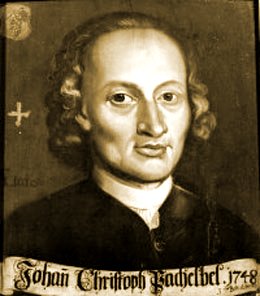Before we get to today's post, a slight vindication for me, and the purpose of this blog: I was watching television last night, and there was a new commercial for that toilet cleaner with Scrubbing Bubbles. Y'know what the music behind it was? That's right. Also Sprach Zarathustra. So now poor old Strauss has to deal with toilet bowls, too.
But yes. Back to today's piece. This composer had the distinct bad luck of following Bach's trajectory from relative anonymity to surprise success, except he predated Bach by 30 years (and is, in fact, the earliest composer featured on Where'd I Hear That thus far! It's the little things, really) and no one cares about any of his other works. However, the one piece he is remembered for has the somewhat dubious honor of, in some ways, representing Baroque music as a whole. That's right, folks - Pachelbel's Canon in D.
 |
| If you look quickly, he looks eerily like Helena Bonham Carter. |
In 1677, Pachelbel moved to Eisenach. And who would he befriend in Eisenach than one Johann Ambrosius Bach, the father of our man Sebastian. He stayed in the town for only a year, but when he moved to Erfurt he stayed quite close to the Bachs - among other things, he was the godfather to one of Ambrosius' daughters, taught his oldest children music, and rented a house owned by one of Ambrosius' brothers. He stayed in Erfurt for a dozen years, and had a contract involving composition of church service organ preludes and large-scale early works. He married in 1681, but his wife and only child died from plague in 1683. His second marriage, in 1684, produced seven children, and one of them - Charles Theodore (moving away from Johann at last!) - moved to the American colonies in the 1730s. Charles lived in Boston, Newport, Rhode Island, and Charleston, South Carolina, and gave several concerts in New York City and was a rather well-known composer of church music in America. While he was raising his children, Johann Pachelbel turned down posts in Stuttgart and Oxford University to accept a position in Nuremberg, where he lived until his death in 1706. In life, he was never hugely well-known, though his influence can be seen through Charles' American church music as well as J.S. Bach's early organ music (due to one of his first teachers being one of his brothers - and Pachelbel's students).
 |
| Ha. Ha. |
As tends to happen, Pachelbel's Canon was entirely ignored, then forgotten, for over two hundred years. It was analyzed in a musciological paper in the 1910s, but stayed in the circles of the truly nerdy (said as a compliment, of course) until 1970, when Jean-François Paillard recorded it in 1970, and more so in 1980, when it was featured in the film Ordinary People. Since then, it has been a staple in the public concept of what Classical Music is - but perhaps its more insidious legacy was that of providing the chord progression to thousands of popular songs since the 1970s. Just ask this angry man with an acoustic guitar (the actual examples start roughly 2 minutes in).
Further listening:
Interested in the bizarre and awesome stuff one can do with the canon form? Try Bach's "Musical Offering," in which he writes a canon that modulates up a step every time there is a repetition (and can go on as long as the player wishes): http://www.youtube.com/watch?v=nsgdZFIdmeo&feature=related
Because I feel bad for the guy, here's the other half of his Canon and Gigue: http://www.youtube.com/watch?v=zv_s4Q6wRKo&feature=related
Wanna hear what a German composer with enough melodrama to kill lesser men (again, said out of love) can do to a well-known and beloved children's round? Try the third movement of Gustav Mahler's "Titan" Symphony no. 1, performed by the San Francisco Symphony Orchestra: http://www.youtube.com/watch?v=WVsLCzSK7Rs
No comments:
Post a Comment